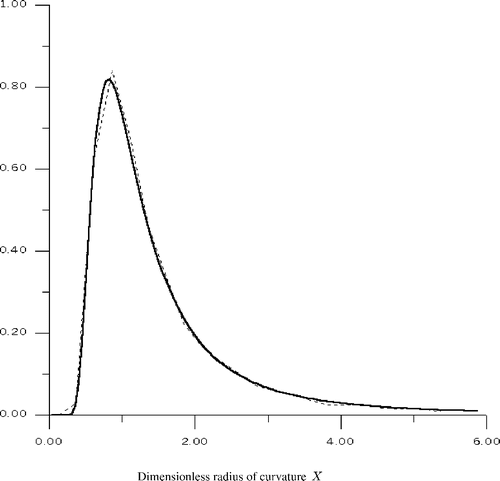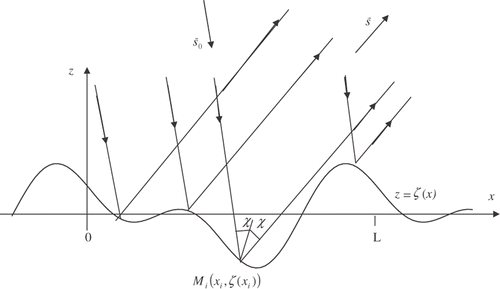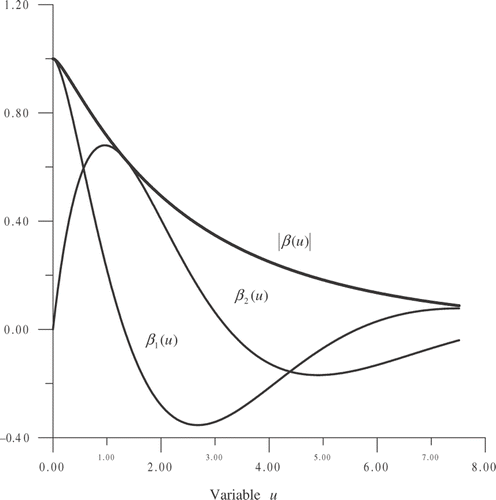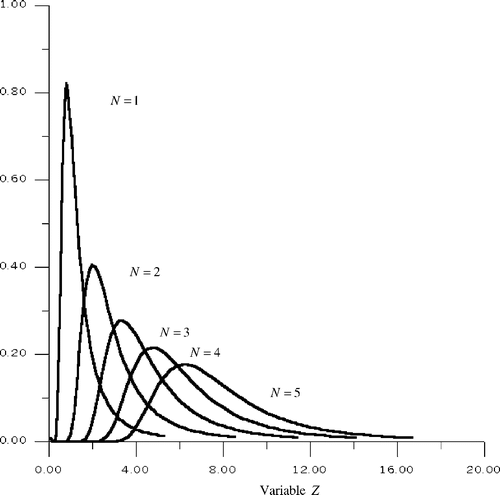Abstract
Statistical characteristics of light reflected by the rough random cylindrical homogeneous Gaussian surface are being investigated by using the method of specular points. The inverse problem, in the form of a Fredholm integral equation of the first kind for determining the distribution of the number of specular points from the known reflected radiance distribution, is formulated. The kernel of this equation is determined by the characteristic function of the distribution of radii of curvature in specular points, derived by Gardashov. The validity of the obtained original formulas is controlled by numerical simulations.
1. Formulation of the problem
It is well known that, in the approach of geometrical optics, the statistical characteristics of the light reflected by a random sea surface are determined by statistical characteristics of mirror reflection (or specular) points Citation1, Citation2. Let a cylindrical homogeneous Gaussian surface z = ζ(x), (⟨ζ(x)⟩ = 0 , σ0² = ⟨ζ²(x)⟩ , σ1² = ⟨ζ'²(x)⟩ , be illuminated by a parallel light beam incident along a unit vector
and let surface segment with a horizontal length L be observed along a unit vector
(). Then, according to the approach called the method of specular points, a random realization of the radiance (surface reflectance), r, of light reflected from surface is given as the sum of contributions of all specular points (SP) Citation3:
(1)
Here, K = πV(χ) cos χ/2|s0z|sz, where V(χ) is the Fresnel reflection coefficient at the local incident angle χ; NL is the number of SP in interval [0, L]; |ρi| = (1 + r2)3/2/|ζ″(xi)| is the radii of curvature at the SP, Mi (xi, ζ(xi)), of the surface z = ζ(x) with a slope:
(2)
The specular points Mi (xi, ζ(xi)) are determined as the solutions of equation:
(3)
The number NL in sum (1) is the number of solutions of equation (3) falling on the observed part of surface z = ζ(x).
Introducing dimensionless radii of curvature
(4)
where
(5)
is the average of radii of curvature |ρi| at the SP Citation4, and denoting
(6)
the formula (1) can be rewritten:
(7)
In the expression (7), the random quantities are the dimensionless radii of curvature Xi and the number of SP, NL. The expression (7) assumes that the light waves reflected by adjacent SP are incoherent. This assumption will be justified if surface rms deviation is σ0 ≫ λ.
For the average radiance from expressions (1) and (7) we have (appendix, Theorem 1):
(8)
where,
, is the average number of SP per unit length. (Note that we fix the averaging by angle brackets). As it can be shown (see formula (14)),
(9)
and, consequently,
(10)
This is a well-known result of method of stochastically distributed areas, which states that the angular distribution of the average radiance reflected from the surface is governed by the distribution W(γ) of surface slopes γ. Thus, the average radiance evaluated by the method of specular points coincides with the average radiance evaluated by the method of stochastically distributed areas.
The main goal of this article is deducing the integral equation for determining the distribution of the number of SP from the known reflected radiance distribution.
2. Distribution of the radii of curvature
The distribution of radii of curvature of rough random cylindrical homogeneous Gaussian surface z = ζ(x) at the SP with slopes ζ′(x) = γ ≡ const. is obtained by the following way: using the results of classical works of Rice Citation5, Citation6, for average value, , of number of SP per unit length, we can write:
(11)
where, by W2(ζ′, ζ″), the joint probability distribution function of derivatives ζ′(x) and ζ″(x) is denoted. The conditional probability distribution function Wc(ζ″\vert γ) of derivative ζ″(x) at the SP, ζ′(x) = γ ≡ const., is expressed by formulae:
(12)
Then for the probability distribution function, Wρ(|ρ|), of the radii of curvature |ρ| = (1 + γ2)3/2/|ζ″| at the SP ζ′(x) = γ ≡ const. we obtain:
(13)
Using the fact that successive derivatives ζ′(x) and ζ″(x) are statistically independent, we have W2(ζ′, ζ″) = W(ζ′)W1(ζ″) and for average value of |ρ| we found:
(14)
Particularly, for Gaussian surface, i.e. when
(15)
from (13) and (14) we have:
(16)
and
(17)
consequently. The distribution (16) expressed in terms of dimensionless radii of curvature,
, is given by the formula:
(18)
The Gardashov's distribution (18) does not contain any parameter; consequently, it is universally valid for any homogeneous Gaussian surface z = ζ(x). It can be easily seen that
and ⟨X2⟩ = +∞. Note that the distribution of the dimensionless radii of curvature with sign,
, is symmetric and it is:
(19)
3. Distribution of the radiance of reflected light
The distribution function Wr(r) of the radiance r can be determined through the characteristic function β(u) of the distribution Wx(X) and the distribution function WN(NL) of the number of SP, NL. From (18) for Wx(X), we obtain the expression for the characteristic function β(u) of the random quantity X:
(20)
As we see, the integral converges uniformly on u in (−∞, +∞). In , the real β1(u), imaginary β2(u) parts and the module |β(u)| of characteristics function β (u) are represented.
It can be shown (appendix, Theorem 2), that the PDF of the sum
(21)
under the assumption of independence X1, X2, …, XN, can be expressed in terms of module
and argument ϕ(u) = arg β(u) = arctan(β2(u)/β1(u)) of characteristic function β(u) as follows:
(22)
If we denote
(23)
then (22) can be rewritten as:
(24)
In the special case when WN(NL) = δ(NL − N) from (24), we have
(25)
which specifies a mean of function G(Z, N), as the distribution of Z when the number of SP, NL, in the sum (21) is fixed and equal to N. In addition, if NL ≡ N = 1 then Z = X and G(X, 1) = Wx(X). The graphs of G(Z, N) are given in . The function G(Z, N) has also a property of universality for any homogeneous Gaussian surface z = ζ(x), as the distribution Wx(X) and its characteristic function β(u).
Note that the strong theoretical estimation of the correlations between X1, X2, …, XN is a difficult problem, in spite of the rough estimation of correlation that can be made, for example, in the case of Gaussian correlation function: . Here l0 is a radius of correlation, which is defined from: B0(l0)/B0(0) = (1/e). Then the radii of correlation of ζ′(x) and ζ″(x) are: l1 ≈ 0.51l0 and l2 ≈ 0.39l0, respectively. For Gaussian surface z = ζ(x) from (11) we have:
. Using the relations
and
, at γ = 0 we obtain:
. Then the mean distance between SP is:
. As we see,
is greater than the radius l2. Therefore we can expect for some weak correlations between X1, X2, …, XN.
The assumption of independence NL from X1, X2, …, XN, is not incredible and may be explained also. Indeed, the more of all X1, X2, …, XN, the less NL. But, due to weak correlations between X1, X2, …, XN the probabilities of this event (becomes simultaneously greater values of all X1, X2, …, XN for an any realization of surface z = ζ(x)) must be very small.
Note that formula (8) contradict to results in Citation9, Citation10. The explanation of this contradiction is given in appendix.
4. Simulation and analysis
We used simulations to test the correctness of the derived analytical formulas. The random cylindrical homogeneous Gaussian surface z = ζ(x) is represented as the sum of harmonics
(26)
where the phases ϵn are uniformly distributed over the interval [0, 2π] and the amplitudes cn are determined from the energy spectrum
. The correlation function of surface z = ζ(x) is taken as Gaussian. Then the spectrum
is also Gausssian. The equation (3) that determines the SP, Mi (xi, ζ(xi)), of the surface z = ζ(x) described by the formula (26), takes the form
(27)
We find numerically all the roots xi of last equation falling on interval [0, L]. Then we calculate radii of curvature |ρi| at the SP, (xi, ζ(xi)). This procedure is repeated for an ensemble of surface realizations {z = ζ(x)}. Thus we obtain the set of realizations of the radii of curvature {|ρ|}at the SP, the set of realizations of the numbers of SP, {NL}, in the horizontal length L, and the set of realizations of the radiance of light {r} reflected from the surface z = ζ(x) with the horizontal length L. From this sets we construct the histograms of the distributions: Wρ(|ρ|)–the radii of curvature |ρ|, WN(NL)–the number of SP, NL, and Wr(r)–the radiance r.
In , the distribution of radii of curvature Wx(X) obtained by the theoretical formula (18) and its histogram are represented.
Figure 4. The distribution of radii of curvature Wx(X) (solid curve) and its histogram (dashed curve).

shows the distribution obtained by using the theoretical formula (24) (with a priori taking normal distribution WN(NL)) and its histogram. Probably, the main courses of the difference in theoretical and simulated curves in are: (1) the correlations between X1, X2, …, XN, which are taken into account automatically in simulation and are neglected in theoretical formula, (2) the computing errors, which must be essentially less than the effect of correlations, because double precision in computing was used. Note that closest of these curves indicates either the weak correlations between X1, X2, …, XN, or the small effect of those correlations to distribution Wr(r).
5. Inverse problem for determination of the distribution of the number of SP
The formula (24) can be considered as an integral equation with respect to unknown function WN(NL). It means that on the known function WZ(Z) the unknown function WN(NL) can be determined by solving the integral equation (24). The kernel of this equation G(Z, N) is a good function. For fixed value N, the function G(Z, N) has one maximum and tends to zero very rapidly and slowly at Z → 0 and Z → +∞, consequently ().
As it follows from (1), (6–8) and (21), if the average of radii of curvature, (or average number of SP
), is defined somehow (i.e., a priori known), then the distribution WZ(Z) of
can be simply derived from Wr(r) as:
(28)
since
is a known quantity.
Thus, equation (24) formulates an inverse problem, in the form of a Fredholm integral equation of the first kind, for determining the distribution of the number of specular points, WN(NL), from the known distribution of reflected radiance, Wr(r). It is well known that this problem is ill-posed and its solution requires a special method of regularization Citation9.
Note that the direct solution of equation (24), by transforming it to the system of linear equations (without any regularization algorithm), gives good results when number of SP, NL, is about five. For large numbers, NL, the system of linear equations becomes ill-posed and needs regularization.
Actually, when we want to derive WN(NL) from Wr(r), the uncertainty arises if a priori are not known as and
. The uncertainty can be removed by using the fact that for different N the distribution of Z, i.e. the curves G(Z, N) are essentially different on form. For instance, we can define
as the value of N which gives the minimum to the function:
(29)
where
is determined from (8) and
.
6. Conclusions
When considering the light reflection from a rough surface, the more general quantity of interest is distribution of reflected light intensity. In this article, the analytical solution of this problem for cylindrical homogeneous Gaussian surface z = ζ(x) is obtained under the assumption: “there are no correlations between radii of curvature at specular points and number of specular points”. The degree of validity of this assumption for different types of correlation functions must be investigated. The closest of theoretical and simulated curves of the distribution Wr(r) () tells us that the effect of correlation is small, at least for a Gaussian correlation function. The result of simulations, in the wide range of parameters l0, σ0, γ, shows the workability of the formulated inverse problem.
The analogous problem can be formulated and solved for a 3D random homogeneous Gaussian surface z = ζ(x, y) (such as a wavy sea surface) for which the convenient expression for the distribution of Gaussian curvature at SP is known Citation10. In this case the solution of the inverse problem may be examined by the natural experiments, also, for instance, by using the ensemble of digital images of Sun glitters.
The future aim of author is to choose an appropriate algorithm of regularization and the application of this method to define the number of SP (glitters) and radii of curvatures of sea surface from the remote sensing dates.
References
- Kravtsov, YA, and Orlov, YI, 1990. Geometrical Optics. Berlin, Heidelberg: Springer Verlag; 1990.
- Bass, FG, and Fuks, IM, 1978. Wave Scattering from Statistically Rough Surfaces. Oxford: Pergamon; 1978.
- Shifrin, KS, and Gardashov, RG, 1985. Model calculations of light reflection from the sea surface, Izvestiya Akademii Nauk SSSR. Fizika Atmosfery i Okeana 21 (2) (1985), pp. 162–169.
- Gardashova, TG, and Gardashov, RG, 2001. Simulation of statistical characteristics of light reflected from the sea surface, Izvestiya, Atmospheric and Oceanic Physics 37 (1) (2001), pp. 67–77.
- Rice, SO, 1944. Mathematical analysis of random noise, Bell System Technical Journal 23 (3) (1944), pp. 282–332.
- Rice, SO, 1945. Mathematical analysis of random noise, Bell System Technical Journal 24 (1) (1945), pp. 46–156.
- Barrick, D, 1968. Rough surface scattering based on the specular point theory, IEEE Transactions on Antennas and Propagation AP-16 (4) (1968), pp. 449–454.
- Barrick, D, and Bahar, E, 1981. Rough surface scattering using specular point theory, IEEE Transactions on Antennas and Propagation AP-29 (5) (1981), pp. 798–800.
- Tikhonov, AN, and Arsenin, VY, 1977. Solutions of Ill-Posed Problems. Washington: V.H. Winston & Sons; 1977.
- Gardachov, RG, 2000. The probability density of the total curvature of a uniform random Gaussian sea surface, International Journal of Remote Sensing 21 (15) (2000), pp. 2917–2926.
- Longuet-Higgens, MS, 1959. The distribution of the sizes of images reflected in a random surface, Proceedings of the Cambridge Philosophical Society 55 (1959), pp. 91–100.
Appendix
A1. Proof of the formula (8)
Theorem 1
Let in the sum
(30)
| a. | the quantities X1, X2, …, XN and N are random variables; | ||||
| b. | X1, X2, …, XN has the same PDF and finite mathematical expectation of E(X); | ||||
| c. | N is a positive integer (N ≥ 1) with finite mathematical expectation of E(N) and PDF of P(N); | ||||
Then, the mathematical expectation of the sum is finite and is:
(31)
Proof
By using the formula of total mathematical expectation we have:
Here E(Z|N = n) is conditional mathematical expectation of Z, i.e. at the fixed N = n.
Thus (A2) is correct.
The formula (A2) coincides with , from which follows (8).▪
Note: As we can see from this proof the independence of random variables X1, X2, …, XN, N is not required.
A2. Proof of the formula (22)
Theorem 2
Let in the sum
| a. | the random variables X1, X2, …, XN > 0, are independent and has the same PDF, Wx(X); | ||||
| b. | the random variable N is positive integer (N ≥ 1) and has PDF, WN(N). | ||||
Then PDF of random variable Z is given by
(32)
where β(u) is a characteristic function of distribution WX(X);
ϕ(u) is an argument of β(u).
Proof
Let the joint PDF of random variables Z and N is WZN(Z, N), and conditionally PDF is WZN(Z|N). Then
(33)
and
(34)
If we denote the joint PDF of random variables X1, X2, …, XN by then from independence of X1, X2, …, XN we have:
Characteristic function, Θ(u), of the distribution of random variable Z at the fixed N (i.e. of the PDF WZN(Z|N)) is:
(35)
Thus
(36)
Then PDF WZN(Z|N) of random variable Z at the fixed N, is expressed in terms of Θ(u) by:
or
(37)
As can be seen, the characteristic function
has properties:
Then
. Therefore, in (A8), first integrand is even function and second integrand is odd function. Using this fact we have:
(38)
Substituting (A9) in (A5), we obtain (A3).
As we see from (A9), the function G(Z, N), which is defined on (23), coincides with PDF, WZN(Z|N).▪
A.3. On contradiction between the formula (8) and results in papers Barrick Citation7, and Barrick and Bahar Citation8
The origin of contradiction between the equation (8) in present article and its 3D analog–the equation (6) in Citation8, is hiding the different meanings of NL in present article and N in equation (6) from Citation8. The quantity NL has a clear geometrical sense: NL is the number of SP in interval [0, L] for a given (any considered) realization z = ζ(x). But N in Citation8 has other meaning: N is the density of SP per unit area with fixed second derivatives ζxx, ζyy, ζxy (in 2D case, N is the density of SP per unit length with a fixed second derivative ζ″). However, , if N is for 2D case.
As we can see, in my consideration, no meanings have the expressions NL·|ρ| and (where, |ρ| is a radius of curvature at SP), because for any realization z = ζ(x) the set of radii
and NL are appeared, but not indefinite one |ρ| at SP. Therefore, we can speak only about the correlation between NL and any fixed |ρi|, i = 1, 2, …, NL from the set
. I think this correlation must be weak, as it's explained earlier in text. In my consideration the averaging of NL is performed on the ensemble of realization of surface {z = ζ(x)} and the averaging of |ρ| is performed on the whole set
within the ensemble {z = ζ(x)}.
But in Citation8 definite meanings have the expressions N·|ρ| and , where the averaging is performed on the ensemble of realization {z = ζ(x)}. Indeed, the random variables N and |ρ| in Citation8 are dependent: the more |ρ|, the less N.
However, the conclusion in Citation8 (which follows from equations (6) and 7 in Citation8), that , is incorrect if the averaging ⟨|r1pr2p|⟩ is performed on the whole set of SP. When the averaging is performed on the whole set of SP, the equation (7) in Citation8 is correct. It follows from Longuet-Higgens Citation11 results.
For density of SP per unit area, Dsp, in Citation11 the following equation is obtained (the symbols and the numeration of equation–on Citation11):
(39)
where
(40)
(41)
The conditional probability distribution of ζ1, ζ2, ζ3 at SP, i.e. where ζ4, ζ5 have given constant values ζ4 = γx = const., ζ5 = γy = const is defined by:
(42)
For average of we found:
Thus,
(43)
In Citation8 symbols equation (A10) is:
(44)
From equation (A11) and equation (16) in Citation8 we obtain:
(45)
Hereby, if the averaging ⟨|r1pr2p|⟩ is performed according to above-mentioned procedure of Citation11 (but not on equation (15) in Citation8, where the integrand has singularity and on equation (10) in Citation7, which is approximation) then the equation (A12) is correct.
Note that equation (A10) or (A11) is the 3D analog of equation (9) in present article.



